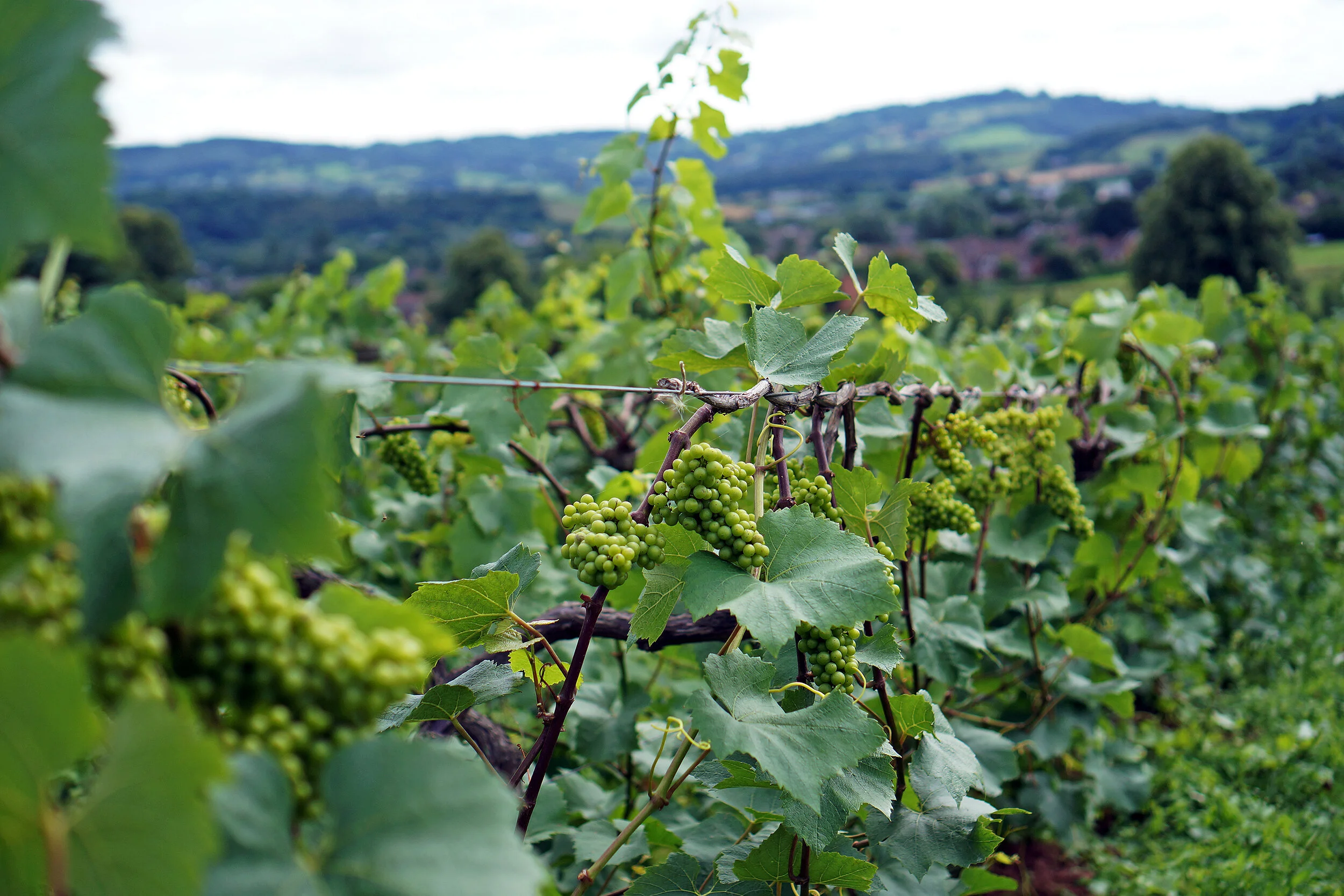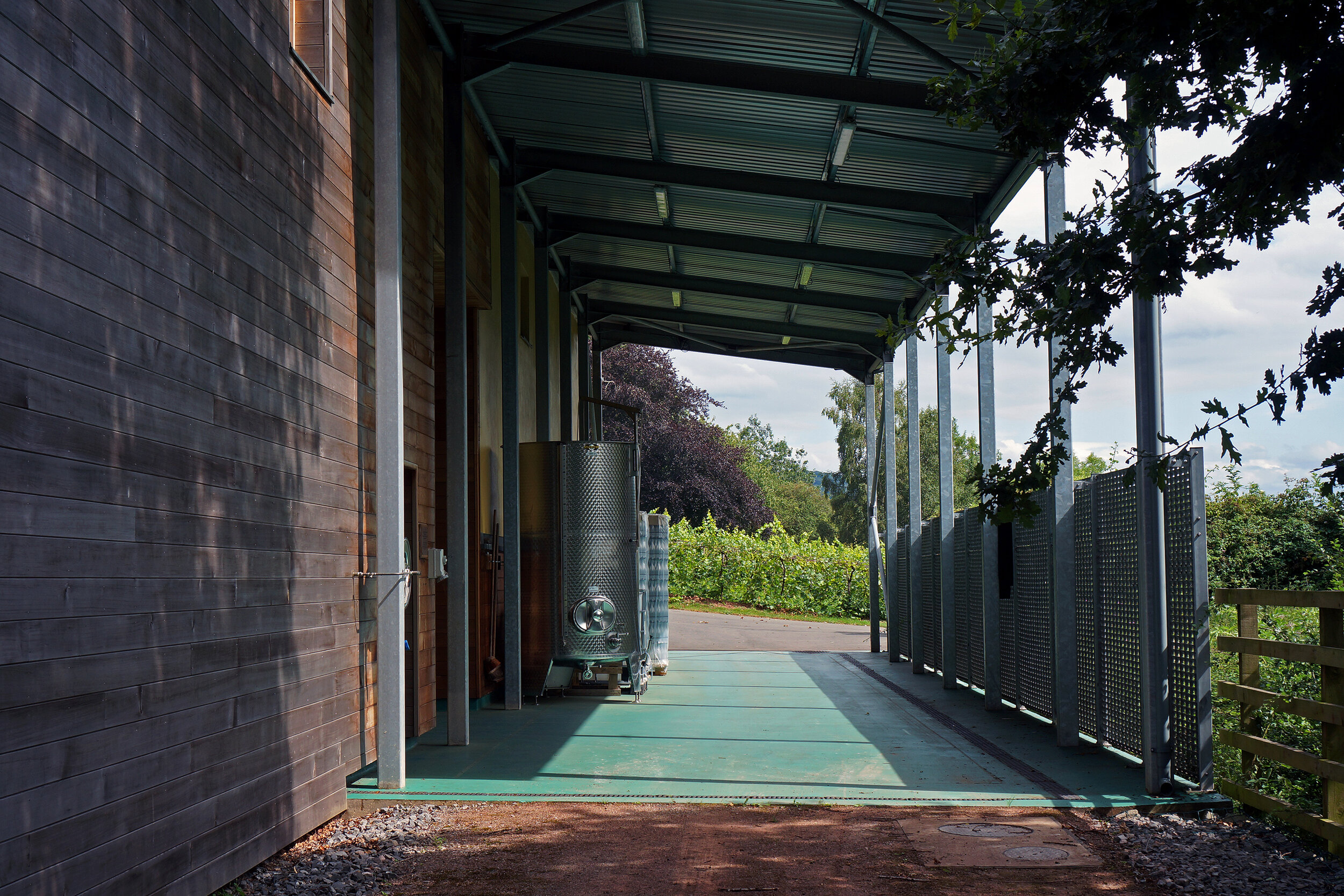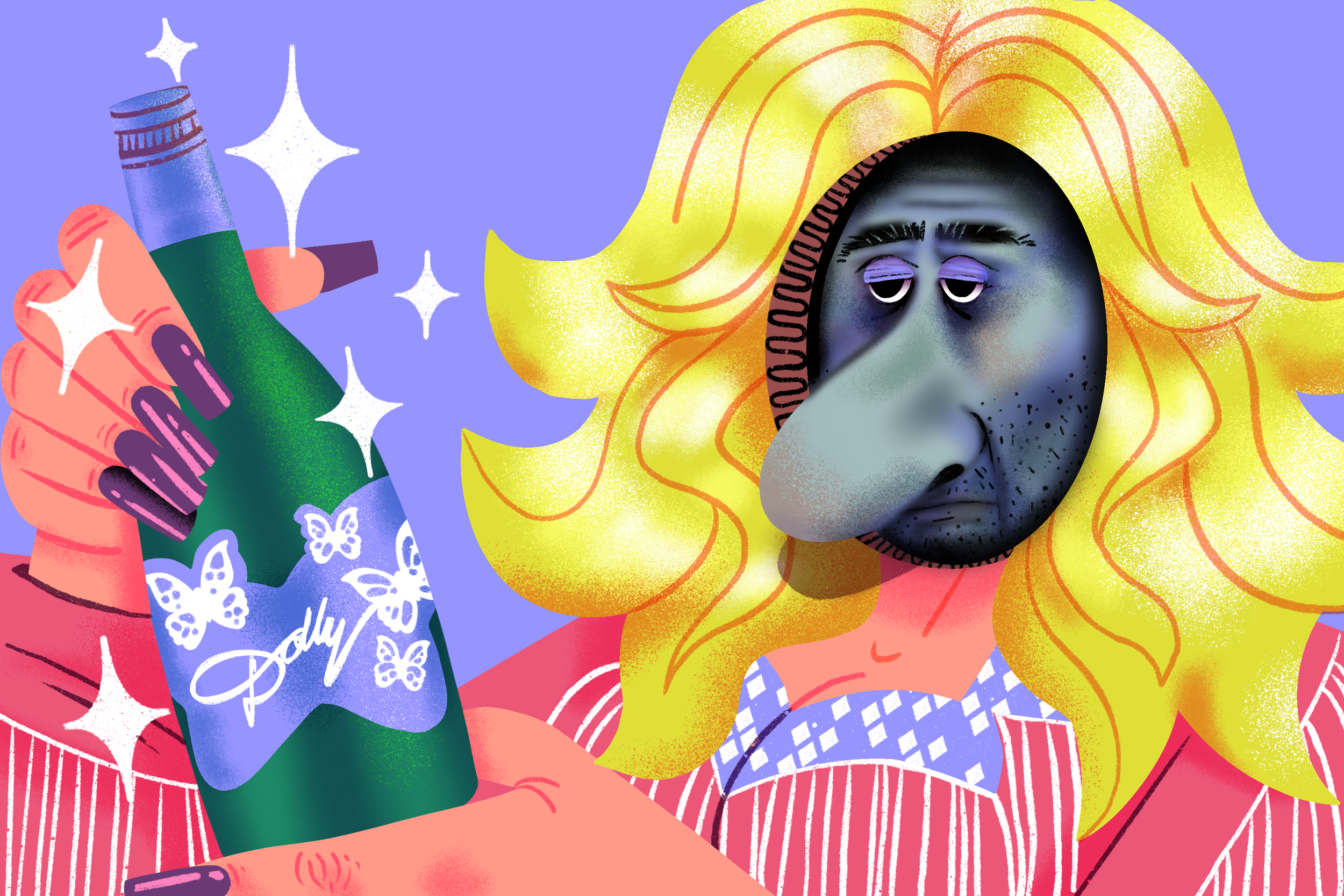Magic Dealer — Making Welsh Wine with Richard Morris of Ancre Hill Estates, Monmouth
It’s the last day of harvest at Ancre Hill.
Emerald sways into bronze as mottled amber crunches underfoot and a dappled grey hangs overhead. Rows of yellowing vines follow the verdant fall of the Wye Valley into the small Welsh town of Monmouth below.
“You can see a buzzard up there, look!” Richard Morris—co-owner of Ancre Hill alongside his wife Joy—exclaims, as we make our way down the hill. Cultivated Albariño gives way to leafy hedgerows of Triomphe d’Alsace. Days earlier the vines would have been heavy with grapes. Now their burden is significantly lighter, only a few stray bunches remaining, small and mean in their refusal to ripen.
Photography by Claire Bullen
“This field has never been used for [growing crops]” Richard explains as I marvel at how startlingly green the grass is. “The soil is some of the richest in the world.”
Finally, we reach the Triomphe, completing our descent, and my eyes dart first to a rare glimpse of black between leaves, then to Richard, seeking permission. He warns me against eating them—too unripe. “If you find any [ripe ones] I’ll be annoyed,” he jokes. Instead, he instructs me to take one in my hand, “if you squeeze it, you can see that natural, red juice.”
I do as he says, gently breaking the grape’s skin between my thumb and forefinger, eyes widening as blood-red trickles down my hand. Then, curiosity driving me to rebellion, I lift my fingers to my lips and my mouth purses—cranberry-sharp acidity exploding against my tongue.
The vast majority of red grapes produce a juice that is white, relying on their skins (and length of skin contact) for their degree of colour. A red grape that naturally exudes ruby is a rarity, it’s what’s known as a teinturier grape; one of the many things that make Triomphe d’Alsace such a special variety.
Earlier we watched the Triomphe being pressed; a larger, mechanical version of my hands causing a cascade of jet-black to roar through the winery before being ushered into fermentation vessels. Stainless steel tanks, concrete eggs and oak barrels, as well as a series of concrete fermenters named after the Seven Dwarves, calmly line the winery walls, their fermentation already underway.
The juice will be bottled in the pétillant-natural method: before fermentation is complete, trapping the last of the carbon dioxide with it. This creates a sparkle so soft that, on opening, the wine will froth and foam like a particularly generous bubble bath.
The pét-nat will be ready in January. When I first taste it I think I’d like to spread it on toast; all plum compote piled onto thick Greek yoghurt, stewed cherries shining with syrup, the soothing softness of sage.
Back among the vines and our attention turns towards the Chardonnay. “Go for one of the mottly ones.” Syrup oozes where acid previously burst, lemon and elderflower sticking to my gums.
The Chardonnay is predominantly used to make both a still wine—the 2018 vintage spikes with green apple, softening to lemon curd as it exhales—and a sparkling, their Blanc de Blancs, which with it’s 2008 vintage won best sparkling wine in the world at the Bollicine Del Mondo competition in Verona.
“We’re looking for phenolic ripeness,” Richard tells me as we continue to weave between the vines. Whereas ripeness is often construed to a desired sugar concentration, phenolic ripeness seeks to ensure a grape’s flavour has developed alongside that sweetness.
“We’re trying to get a lot of the flavour of the fruit into that first fermentation [and then] we inoculate with a neutral yeast, everyone else does it the other way around.”
The result? A 2013 vintage of the Blanc de Blancs that glistens gold and shimmers with life, tasting like hunks of crusty bread and handfuls of candied citrus peel with the saline dryness I associate with sherry, all combined with a rolling apricot fizz that pricks methodically across my tongue. I drink it and for a brief moment, I believe in magic.
***
The history of Welsh wine is, as you may imagine, brief, with a cyclical timeline of vineyards introduced only to be uprooted under the varying influences of the Roman Empire, Henry VIII, European nobility and the World Wars. The Welsh vineyard scene as we know it today didn’t start until the 1960s, making Wales a particularly new New World region, relatively free from regulations, giving its winemakers freedom to experiment as they please.
“We started as a bit of a hobby,” Richard tells me of his decision to start planting vines.
Conversations with neighbouring vineyard Three Choirs—“Triomphe is the one”—and the help of his wife Joy and their children saw Richard planting five hundred Triomphe vines on the grounds of his home in 2006.
From then, quite the exponential growth. Those five hundred vines have now multiplied to some thirty thousand, the original Triomphe is now neighboured with Chardonnay, Pinot Noir, Albariño and a little Pinot Meunier. The original vineyards threaded into the elevation of Ancre Hill have now expanded onto the neighbouring Newton Court Farm and what can only be described as a show-stopping winery has been built on both the grounds and the biodynamic philosophies that have been embraced by Ancre Hill since 2013.
“The environment is so important to us,” Richard says of their decision to turn to biodynamics. “There’s no chemicals used in the vineyard, you know what you’re drinking.”
“There are two things I hate: the use of chemicals, but also chaptalisation,” he goes on. “You’re allowed to increase the alcohol by 3%, but what's wrong with a 9% still wine? Why do you have to make it 11.5% by adding sugar?”
““I lift my fingers to my lips and my mouth purses—cranberry-sharp acidity exploding against my tongue””
Ancre Hill is the only vineyard in Wales to adopt biodynamics. A holistic practice, free from chemical additions that works to align winemaking activities with the movements of the moon and the planets, biodynamics was first created by Rudolf Steiner in 1924. Composing such a harmonious balance requires time, hard work and incredible attention to detail. And due to Britain’s unpredictable weather not lending itself to an agriculture free of chemical help, is not one for the faint-hearted.
“I’ve known of and tasted the Ancre Hill Wines for a few years” Doug Wregg, Director and Wine Buyer for distributor Les Caves de Pyrene, tells me over email.
“I was very impressed with the wines; there was a theme (and a seam) running through them. They were built on the combination of acidity, lees-ageing [lees are dead yeast cells left after fermentation. When left to age on them a wine develops a softened complexity] and minerality, which are the foundations of good natural wines.”
“I don’t like buying unless I have stood in the vineyard and touched the grapes and shaken the dirt from my shoes! We did all that; the vineyards are in great condition, a testament to good biodynamic practices,” Doug adds.
***
Fourteen years on from the Morris’ first plantings and retirement now calls. The property is up for sale and Richard is preparing to hand over the vineyard when new owners are found.
Looking back on his time here, while there is no favoured vintage or wine for Richard—each one bringing “an exciting and different offering reflecting what happened in the vineyard that season”—a clear success of his time at Ancre Hill is his Orange Wine—“it’s our biggest seller.”
Made from Albariño—“we were looking for an aromatic variety, it was either going to be Albariño or Riesling,” Richard says—Ancre Hill’s Orange Wine has an amber, lava-lamp glow, tasting just as vibrant; like rough nectarine skins grazing against your lips, sucking the last remnants of a mango from its stone or maybe even the soft spike of ginger mingling with blossom honey and sharp lemon.
Reflecting on what has been achieved in this unassuming corner of Monmouth lies not just a moment of well deserved proud retrospection for Richard, but an opportunity for guiding Welsh wine into its future as well.
“I’ve tried to persuade the Welsh wine industry that we should push for organics and that we should only grow certain varieties in Wales,” he says. “I’m pushing to grow Ortega and to make orange wine.”
It will be interesting to see who, if anyone, takes note. Wales and its wine have yet to be defined by any regulated grape or style, with most winemakers so far rightly replicating the success of English vineyards, shying away from risks or rarity. Orange wine is scarce on the ground outside of these sloping fields.
As our conversation flits between vintages and grapes and the trials and tribulations of viticulture it is clear that the weather has been as much of a partner in Richard’s venture as anyone else, if not more so. When I ask him what has been the most challenging aspect of his winemaking career the response is “always weather… in our view, this will always be the number one threat to UK viticulture,” he replies.
“The problem with climate change isn’t hotter summers, it’s the erratic weather… air frost is the thing I really worry about,” Richard adds, eyes scanning the vines, hands absentmindedly inspecting the recent pruning.
“You must know these vines so well”, I think out loud.
“I know it inside out and back to front,” he responds.
***
There is a Welsh word, cynefin, which like so many of its siblings doesn’t directly translate to English. As a noun—scientifically—it can mean habitat or haunt. As an adjective—poetically—it can mean familiar, or intimate. Together they lend themselves to when the nature around you feels right and welcoming, a person’s natural habitat.
I think of cynefin when I think of Richard amongst the vines, his ease matching his knowledge, and when I think of the vines themselves. Wales isn’t known for its wine but these grapes, and the fleeting sense of magic they cause me to believe in, belong here.
As we near the end of our walk I ask Richard what his plans for retirement are.
“‘We’ve bought a little place five miles up the road and it has a wonderful little south-facing plot,” he pauses and I smile. “So I might plant Ortega and make orange wine.”
“As long as I don’t upset the new owners,” he adds, quickly.
I very much doubt he would. If they have any sense of their own they’ll be closely planting Ortega in his footsteps.


































